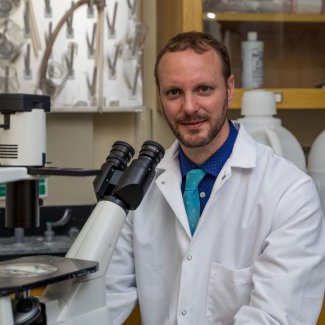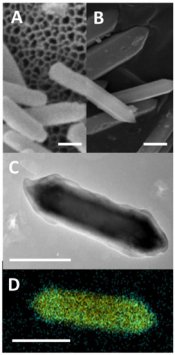Editor’s note: Reineke, an associate professor joined the SDSU faculty in 2015 from Wayne State in Detroit and is the first in the college to receive National Institutes of Health R01 funding.

The mention of tuberculosis (TB) conjures ideas of an old-world disease that is either a problem of the past or a problem for developing nations, but both images are misleading. While TB is a very old disease with the first recorded case occurring over 3,300 years ago (the end of the Bronze Age, when the first forms of paper were developed by Egyptians), it still kills 1.4 million people per year today.
While TB has its highest prevalence in India, Indonesia and China, it is a global health threat with an estimated 13 million people in the United States living with latent TB and 9,000 active cases per year. My lab has partnered with leading researchers in South Africa to develop a novel therapy that aims to truly make TB a disease of the past.
Researching TB treatments has been a long-standing interest of mine, but it was only in the past couple of years that my lab began work on novel TB treatments.
Two postdoctoral scholars, Mikhail Durymanov and Anastasia Permyakova, and I were discussing Anastasia’s work on novel materials for energy storage. The metal-organic frameworks (MOFs) can be synthesized of nontoxic materials, grown in specific shapes and sizes, are porous and can be designed with various chemistries.
From this initial conversation, we developed an approach to use these materials as a drug-delivery system that can mimic M. tuberculosis, the bacterium that causes TB.
The materials can be made in the same shape and size of the bacterium and can be modified on the surface with a coating of similar chemistry as the bacterium. Our hypothesis was that this would allow the particles to follow the same pathway as the bacterium when administered to the lung—getting into the same cells, same region of the cells and transported past the granuloma barrier.

Further, the porous particles can act as a drug reservoir to release a therapeutic over time, potentially mitigating the need for long-term complex treatment regimens. Rather than delivering an antibiotic, we built on recent literature that proposed a host-directed approach and selected agents that could interfere with the bacterium and host cell interaction. This allows effective treatment of even drug resistant and latent infections.
We teamed with a leading world expert in MOFs, Christian Serre, at the Institute of Porous Materials in Paris, to begin working with our first frameworks.
Mikhail and graduate student Ailin Guo did the first proof-of-concept studies. Research support from SDSU, the South Dakota Board of Regents and the State of South Dakota was instrumental in these early phases.
When the National Institutes of Health put out a call for joint projects in the area of tuberculosis between U.S. and South African researchers, a fellow nanomedicine researcher, Admire Dube at the University of Western Cape and I teamed with a leading TB researcher, Samantha Sampson at Stellenbosch University, to submit an application.
The NIH has funded the project for $1.7M. We are starting our second year of the project with graduate student Cindy Venegas Mata taking a lead. She is assisted by undergraduate Jadyn Perry. We will begin to test the biomimetic formulations synthesized in my lab at SDSU and also those developed by Dube in the TB models in Sampson’s lab.
While the work is in its early stages, we are excited at the potential to end TB.
TB and COVID-19
Prior to the COVID-19 pandemic, TB was the highest cause of death from a single infectious agent.
In 2020, nearly 2 million people died from COVID-19, compared to the annual rate of 1.4 million deaths from TB.
The devastation from COVID-19 puts into perspective the lesser-publicized devastation from TB. The pandemic has also brought greater public awareness to infectious diseases and has removed the stigma of wearing a mask, which may both contribute to a reduced spread of TB.
In some key TB countries, diagnosed TB cases are down by more than 15%. Whether this is the result of underdiagnosis or reduced infection will not be known until after the pandemic subsides.
- Contact:
- Telephone number: 605-688-4241
Republishing
You may republish SDSU News Center articles for free, online or in print. Questions? Contact us at sdsu.news@sdstate.edu or 605-688-6161.

